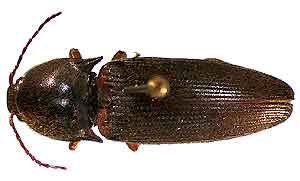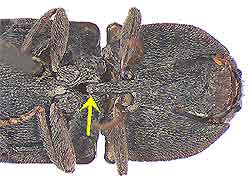
|
ELATERIDAE Click Beetles |
|
| ||||||||||||
|
Most click beetles are slender and elongate in shape and range from about 4 to 50 millimetres in length. They are usually drab-coloured and have serrated antennae. Adults are nocturnal and are often attracted to lights at night. They sometimes enter houses and can often be seen on the bark of trees and flowers.
The larvae of click beetles are commonly known as wireworms. They are elongate and cylindrical in shape, have hardened abdominal segments and are usually shiny yellow to orange-brown in colour. They may be either herbivorous, feeding on plant roots or carnivorous and feed on other insect larvae and soft-bodied invertebrates. Click beetles are a favourite with children as they can arch their backs and flick up into the air with a distinct clicking sound. This is made possible due to a peg-like structure which projects backwards from the underside of the prothorax and fits into a cavity in the mesothorax.
The click beetle bends its body to enable the peg to snap into the cavity causing its body to straighten so suddenly that it somersaults into the air. This jumping is a defence tactic that allows the beetle to evade a predator. For more click beetle species visit the Australian Insect Common Names - Elateridae section found here. |

